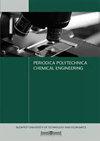Study on Corrosion Characteristics of Aluminum Alloy Al3102 in Sulfate-reducing Bacteria Environment and Investigating the Use of Azadirachta indica Leaves Extract in its Control
IF 1.8
4区 工程技术
Q3 ENGINEERING, CHEMICAL
引用次数: 0
Abstract
An effort to understand the corrosion characteristics of aluminium Al3102 alloy in a neutral medium in the presence of Desulfovibrio desulfuricans was made. The corrosion rate increased up to tenfold in the bacterial medium in comparison to the control (abiotic) medium. Scanning electron microscopy (SEM) studies showed substantial sulfate-reducing bacteria (SRB) adhesion on the alloy surface and pit formation. Supplementation of 1000 ppm Azadirachta indica leaves extract decreased corrosion by 82%. Sulfide analysis, SEM, and X-ray photoelectron spectroscopy (XPS) studies showed a significant effect of neem leaf extract (NLE) on bacterial metabolic activity and confirmed the adsorption of the inhibitor molecules on Al3102 surface. Electrochemical impedance spectroscopy studies showed that the NLE formed a highly resistive external layer which protected the alloy surface from the corrosive effects. The gas chromatography-mass spectroscopy studies (GC-MS) showed appreciable amount of esters, terpenoids, heterocyclic nitrogen, sulfur compounds, and organic bromine compounds in NLE.Al3102铝合金在硫酸盐还原菌环境中的腐蚀特性及印楝叶提取物的防治研究
研究了Al3102铝合金在中性介质中脱硫弧菌存在下的腐蚀特性。与对照(非生物)培养基相比,细菌培养基中的腐蚀速率增加了10倍。扫描电镜(SEM)研究表明,合金表面有大量的硫酸盐还原菌(SRB)粘附并形成凹坑。添加1000 ppm的印楝叶提取物可减少82%的腐蚀。硫化物分析、扫描电镜和x射线光电子能谱(XPS)研究表明,印度楝叶提取物(NLE)对细菌代谢活性有显著影响,并证实了抑制剂分子在Al3102表面的吸附作用。电化学阻抗谱研究表明,NLE形成了一层高阻性的外膜,保护合金表面免受腐蚀影响。气相色谱-质谱分析(GC-MS)表明,NLE中含有大量的酯类、萜类、杂环氮、硫化合物和有机溴化合物。
本文章由计算机程序翻译,如有差异,请以英文原文为准。
求助全文
约1分钟内获得全文
求助全文
来源期刊

Periodica Polytechnica Chemical Engineering
ENGINEERING, CHEMICAL-
CiteScore
3.10
自引率
7.70%
发文量
44
审稿时长
>12 weeks
期刊介绍:
The main scope of the journal is to publish original research articles in the wide field of chemical engineering including environmental and bioengineering.
 求助内容:
求助内容: 应助结果提醒方式:
应助结果提醒方式:


